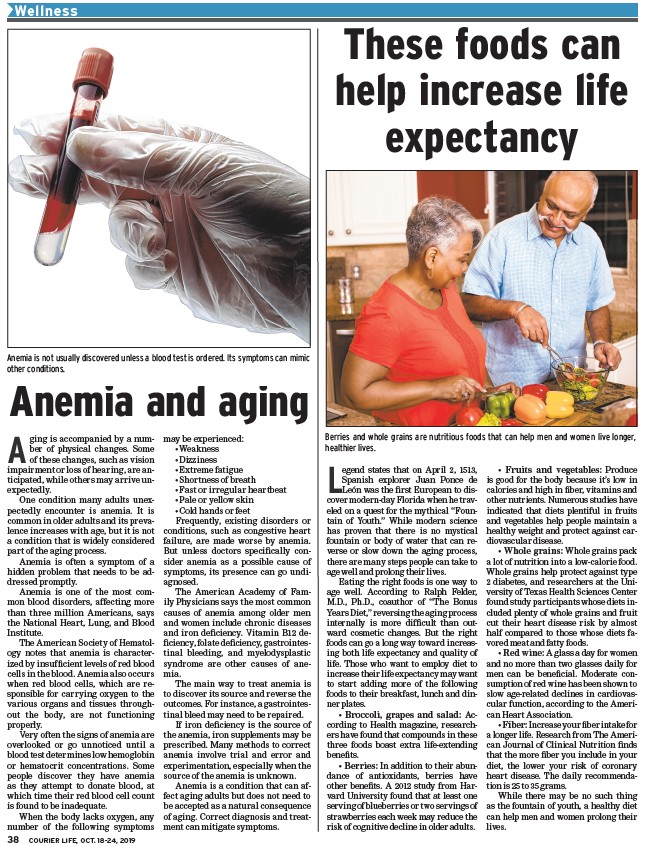
Anemia is not usually discovered unless a blood test is ordered. Its symptoms can mimic
other conditions.
Anemia and aging
Aging is accompanied by a number
of physical changes. Some
of these changes, such as vision
impairment or loss of hearing, are anticipated,
while others may arrive unexpectedly.
One condition many adults unexpectedly
encounter is anemia. It is
common in older adults and its prevalence
increases with age, but it is not
a condition that is widely considered
part of the aging process.
Anemia is often a symptom of a
hidden problem that needs to be addressed
promptly.
Anemia is one of the most common
blood disorders, affecting more
than three million Americans, says
the National Heart, Lung, and Blood
Institute.
The American Society of Hematology
notes that anemia is characterized
by insuffi cient levels of red blood
cells in the blood. Anemia also occurs
when red blood cells, which are responsible
for carrying oxygen to the
various organs and tissues throughout
the body, are not functioning
properly.
Very often the signs of anemia are
overlooked or go unnoticed until a
blood test determines low hemoglobin
or hematocrit concentrations. Some
people discover they have anemia
as they attempt to donate blood, at
which time their red blood cell count
is found to be inadequate.
When the body lacks oxygen, any
number of the following symptoms
COURIER L 38 IFE, OCT. 18-24, 2019
may be experienced:
• Weakness
• Dizziness
• Extreme fatigue
• Shortness of breath
• Fast or irregular heartbeat
• Pale or yellow skin
• Cold hands or feet
Frequently, existing disorders or
conditions, such as congestive heart
failure, are made worse by anemia.
But unless doctors specifi cally consider
anemia as a possible cause of
symptoms, its presence can go undiagnosed.
The American Academy of Family
Physicians says the most common
causes of anemia among older men
and women include chronic diseases
and iron defi ciency. Vitamin B12 defi
ciency, folate defi ciency, gastrointestinal
bleeding, and myelodysplastic
syndrome are other causes of anemia.
The main way to treat anemia is
to discover its source and reverse the
outcomes. For instance, a gastrointestinal
bleed may need to be repaired.
If iron defi ciency is the source of
the anemia, iron supplements may be
prescribed. Many methods to correct
anemia involve trial and error and
experimentation, especially when the
source of the anemia is unknown.
Anemia is a condition that can affect
aging adults but does not need to
be accepted as a natural consequence
of aging. Correct diagnosis and treatment
can mitigate symptoms.
Wellness
These foods can
help increase life
expectancy
Berries and whole grains are nutritious foods that can help men and women live longer,
healthier lives.
Legend states that on April 2, 1513,
Spanish explorer Juan Ponce de
León was the fi rst European to discover
modern-day Florida when he traveled
on a quest for the mythical “Fountain
of Youth.” While modern science
has proven that there is no mystical
fountain or body of water that can reverse
or slow down the aging process,
there are many steps people can take to
age well and prolong their lives.
Eating the right foods is one way to
age well. According to Ralph Felder,
M.D., Ph.D., coauthor of “The Bonus
Years Diet,” reversing the aging process
internally is more diffi cult than outward
cosmetic changes. But the right
foods can go a long way toward increasing
both life expectancy and quality of
life. Those who want to employ diet to
increase their life expectancy may want
to start adding more of the following
foods to their breakfast, lunch and dinner
plates.
• Broccoli, grapes and salad: According
to Health magazine, researchers
have found that compounds in these
three foods boast extra life-extending
benefi ts.
• Berries: In addition to their abundance
of antioxidants, berries have
other benefi ts. A 2012 study from Harvard
University found that at least one
serving of blueberries or two servings of
strawberries each week may reduce the
risk of cognitive decline in older adults.
• Fruits and vegetables: Produce
is good for the body because it’s low in
calories and high in fi ber, vitamins and
other nutrients. Numerous studies have
indicated that diets plentiful in fruits
and vegetables help people maintain a
healthy weight and protect against cardiovascular
disease.
• Whole grains: Whole grains pack
a lot of nutrition into a low-calorie food.
Whole grains help protect against type
2 diabetes, and researchers at the University
of Texas Health Sciences Center
found study participants whose diets included
plenty of whole grains and fruit
cut their heart disease risk by almost
half compared to those whose diets favored
meat and fatty foods.
• Red wine: A glass a day for women
and no more than two glasses daily for
men can be benefi cial. Moderate consumption
of red wine has been shown to
slow age-related declines in cardiovascular
function, according to the American
Heart Association.
• Fiber: Increase your fi ber intake for
a longer life. Research from The American
Journal of Clinical Nutrition fi nds
that the more fi ber you include in your
diet, the lower your risk of coronary
heart disease. The daily recommendation
is 25 to 35 grams.
While there may be no such thing
as the fountain of youth, a healthy diet
can help men and women prolong their
lives.